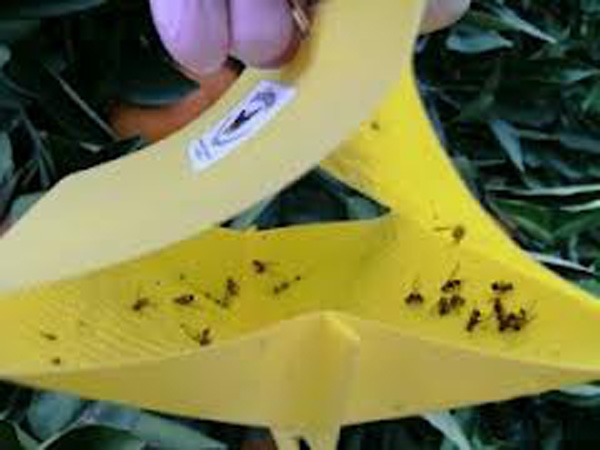Last month we looked at trapping and monitoring QFF.
This month we look at control measures.
Trapping is the first step to knowing how many QFF you are dealing with; that you actually have them on your orchard; and how many you have—hopefully before maggots are detected in your fruit.
Whether you are in one of the two new QFF Suspension zones, or the Greater Victoria section of the state which is not covered by any QFF management zone, QFF is going to become a major issue if you are growing fruit or vegetables.
The Greater Sunraysia Pest Free Area at present is the isolated QFF free area while outbreaks are eradicated.
QFF control options
QFF control has a few key options—some are IPM sensitive, some are not.
QFF is so devastating in its damage to fruit that IPM may be placed second to the economic need to save the crop.
Trapping
With traps out you catch QFF! Then your on-farm eradication and control program needs to begin.
The DPI consider an outbreak to be five QFF caught over 14 days—that’s a low number in a trap!
The QFF traps need to be sensitive, and regularly monitored to pick up the first flies.
The number of traps can be increased in an area to locate a hot spot. Not many QFF are needed to cause serious damage.
Hygiene
Remove and dispose of any fruit left on trees, any fruit that remains after packing, and fruit from roadside feral trees.
Be watchful of any fruit or vegetables brought onto the farm by friends, neighbours or visitors.
Hygiene—removing all fruit from trees—is difficult to do, but is also important for control of Carpophilus beetle, brown rot, mealy bug, OFM and codling moth as well as QFF.
Bait spraying
Apply bait spray into the foliage of the trees to control the QFF. This is a tried and proven method of control, but needs to be done diligently and regularly (every seven days).
The whole orchard area with susceptible fruit coming up to harvest, and the areas that been harvested, should be treated.
Attract & Kill
Attract and kill QFF using the Amulet Cuelure Stations or MAT (Male Annihilation Technique) cups.
The male QFF is attracted to the station or cup by the parapheromone Cuelure, and is then killed by an insecticide in the station or cup.
Foliar spraying—a hot topic
Discuss foliar spraying with your agronomist as some insecticides will give knockdown of QFF, but have a short residual action, if any.
Recent work by Qld DPI and the investigation by Summerfruit into the performance of currently used chemicals will increase the range of control options.
Trichlorofon can be effective if used early—before the QFF establishes—but check the status of registered products and permits for the latest information.
Limited control options
The control options for QFF are limited.
Stone fruit is extremely attractive to QFF and their numbers seems to explode if not addressed very early and quickly.
All the options for control, except foliar spraying, are typical IPM methods and strategies.
All the strategies and options will need to be used to control QFF; there is no stand-alone or single method of control for QFF.
Foliar spraying is of course the least IPM compatible. The effectiveness of available chemicals is determined by their label constraints, withholding periods (WHP) and number of applications that can be made.
The real negative to foliar spraying is the effect on beneficial insects in your orchards, and the impact these chemicals can have to flair any secondary pests.
Two Spotted Mite is already a problem this season, extra sprays for QFF that can flair this pest.
Community involvement results in long term control
Long term control options involve the whole community.
Many fruit growing areas are close to towns, and towns have QFF populations. A combined approach where a town and growers work together to manage QFF will give long term control.
Areas such as Young, Griffith, and Cobram with Moira and Berrigan shires, have action groups that are taking this approach.
Great example
The locality of Invergordon is a good illustration. The Invergordon area of Victoria primarily produces canning peaches and pears. It lies on a major route between northern and central Victoria, and has experienced QFF outbreaks over the last few years.
As soon as the first QFF were seen this season, the growers ramped up their trapping network, installed Attract & Kill stations and started their bait spraying program.
Letter-box drops to all the households in the area informed and encouraged everyone to help stop QFF from establishing in the area. So far so good, some flies have been caught, but no fruit damage.
This is an admirable group that has taken action themselves.
Invergordon has no OFM because they have used mating disruption for many years in the peaches. This has fostered their IPM programs.
With regular trap monitoring for a number of pests, crop inspections and—most importantly—a positive attitude, they have taken responsibility for looking after their own crops*.
QFF to become a major threat
QFF is set to become a major threat to fruit growing in southern Australia.
At present there are few control options available, and all are needed to control the pest from causing fruit damage.
If you have not experienced QFF, we are envious. But be aware that over the next few seasons, QFF will become a major menace.
*For information on the Invergordon group, email
For Warning, Notes and images, see February 2013 Tree Fruit




















